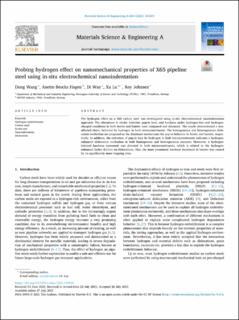| dc.contributor.author | Wang, Dong | |
| dc.contributor.author | Hagen, Anette Brocks | |
| dc.contributor.author | Wan, Di | |
| dc.contributor.author | Lu, Xu | |
| dc.contributor.author | Johnsen, Roy | |
| dc.date.accessioned | 2022-05-09T07:37:33Z | |
| dc.date.available | 2022-05-09T07:37:33Z | |
| dc.date.created | 2021-07-29T14:41:00Z | |
| dc.date.issued | 2021 | |
| dc.identifier.citation | Materials Science and Engineering: A, 2021 (824), 141819, 1-10. | en_US |
| dc.identifier.issn | 0921-5093 | |
| dc.identifier.uri | https://hdl.handle.net/11250/2994669 | |
| dc.description.abstract | The hydrogen effect on a X65 carbon steel was investigated using in-situ electrochemical nanoindentation approach. The alterations in elastic behavior, pop-in load, and hardness under hydrogen-free and hydrogen-charged conditions in both ferrite and bainite were compared and discussed. The results demonstrated a non-affected elastic behavior by hydrogen in both microconstituents. The homogeneous and heterogeneous dislocation nucleation are proposed as the dominant mechanisms for pop-in behavior in ferrite and bainite, respectively. In addition, the reduction of pop-in load by hydrogen in both microconstituents indicates a hydrogen-enhanced dislocation nucleation in both homogenous and heterogeneous manners. Moreover, a hydrogen-induced hardness increment was detected in both microconstituents, which is related to the hydrogen-enhanced lattice friction on dislocations. Also, the more prominent hardness increment in bainite was caused by its significantly more trapping sites. | en_US |
| dc.language.iso | eng | en_US |
| dc.publisher | Elsevier | en_US |
| dc.rights | Navngivelse 4.0 Internasjonal | * |
| dc.rights.uri | http://creativecommons.org/licenses/by/4.0/deed.no | * |
| dc.subject | Dislocation | en_US |
| dc.subject | Nanoindentation | en_US |
| dc.subject | In-situ test | en_US |
| dc.subject | Carbon steel | en_US |
| dc.subject | Hydrogen embrittlement | en_US |
| dc.title | Probing hydrogen effect on nanomechanical properties of X65 pipeline steel using in-situ electrochemical nanoindentation | en_US |
| dc.type | Peer reviewed | en_US |
| dc.type | Journal article | en_US |
| dc.description.version | publishedVersion | en_US |
| dc.rights.holder | © 2021 The Authors. Published by Elsevier B.V. | en_US |
| dc.source.pagenumber | 1-10 | en_US |
| dc.source.volume | 824 | en_US |
| dc.source.journal | Materials Science & Engineering: A | en_US |
| dc.identifier.doi | 10.1016/j.msea.2021.141819 | |
| dc.identifier.cristin | 1923043 | |
| dc.relation.project | Norges forskningsråd: 294739 | en_US |
| dc.relation.project | Norges forskningsråd: 294689 | en_US |
| dc.source.articlenumber | 141819 | en_US |
| cristin.ispublished | true | |
| cristin.fulltext | original | |
| cristin.qualitycode | 2 | |

